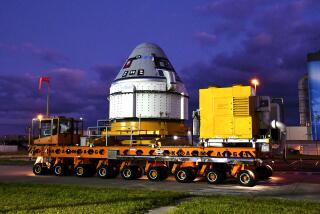Thunderstorms in Area Not Expected to Halt Liftoff : Smooth Launch Predicted for Challenger
- Share via
KENNEDY SPACE CENTER, Fla. — Space agency officials expressed concern Tuesday about thunderstorms associated with Hurricane Juan but predicted a successful launch today of the 22nd space shuttle mission, the first to be controlled in part from another country.
National Aeronautics and Space Administration officials said they expected showers, which drenched the shuttle Challenger on its launch pad Tuesday afternoon, to continue today as the hurricane weakened along the Mississippi-Alabama coast.
But they predicted that frequent breaks in the cloud cover would allow Challenger to lift off during a three-hour launch “window” beginning at 9 a.m. PST.
Ready for Launch
“The bottom line here today is we’re ready to launch tomorrow,” NASA Associate Administrator Jesse Moore said.
Challenger, on its ninth trip into space, will carry a record crew of eight, including three European scientists. Several previous shuttle flights carried crews of seven.
Crew members will split into dual 12-hour work shifts, providing round-the-clock scientific operations during the seven-day flight.
For the first time in space agency history, scientists at NASA’s Johnson Space Center near Houston will relinquish control of the shuttle’s payload operations once the craft achieves orbit 201 miles above the Earth.
Spacelab Experiments
West Germany is paying NASA about $65 million to carry the European-assembled Spacelab mobile laboratory aloft to conduct 76 low-gravity experiments, ranging from metals research to attempts to pinpoint the cause of space motion sickness.
Scientists at the German Space Operations Center in Oberpfaffenhofen, near Munich, will have control over the experiments, while NASA officials will retain authority over the spaceship itself.
Challenger also will place in orbit a military communications satellite that failed to deploy during a shuttle flight in April and will test a computerized nose-wheel steering system upon landing at Edwards Air Force Base in California on Nov. 6.
Today’s flight is the first of what NASA hopes will be numerous foreign charters of the shuttle and will be a key element in helping European nations decide whether to participate in the U.S. space station project.
More to Read
Sign up for Essential California
The most important California stories and recommendations in your inbox every morning.
You may occasionally receive promotional content from the Los Angeles Times.










